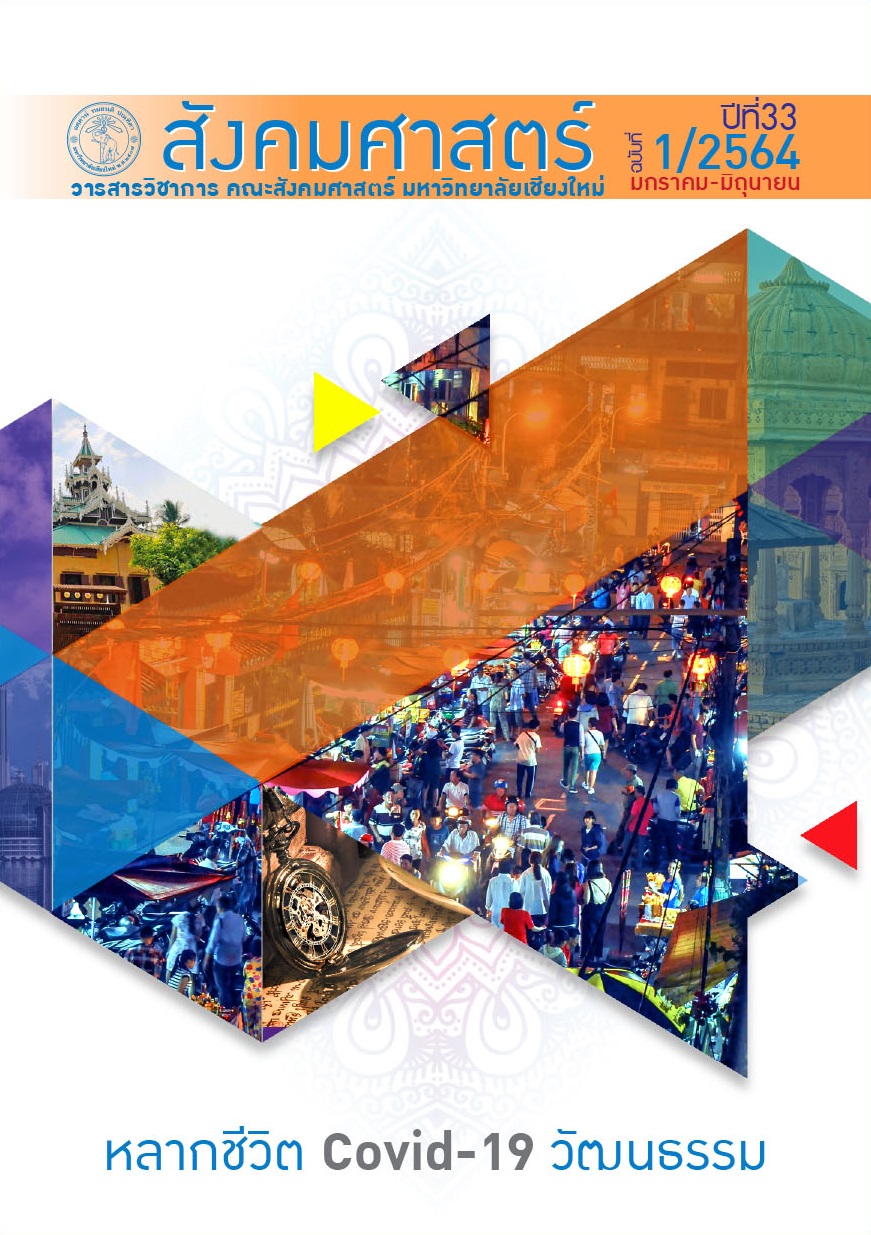การต่อรองเรื่องเล่าและอัตลักษณ์ทางชาติพันธุ์ของจีนเปอรานากันในรัฐกลันตัน ประเทศมาเลเซีย
Main Article Content
บทคัดย่อ
บทความนี้ศึกษาการต่อรองทางชาติพันธุ์โดยใช้วิธีการสร้างเรื่องเล่าในชีวิตประจำวันและการเล่าผ่านวัตถุในพิพิธภัณฑ์ชุมชนซึ่งเป็นวิธีการให้นิยามกับตัวตนของกลุ่มชาติพันธุ์จีนเปอรานากันในรัฐกลันตัน กลุ่มชาติพันธุ์เผชิญปัญหาความคลุมเครือเนื่องจากการผสมผสานทางวัฒนธรรมกับกลุ่มชาติพันธุ์ในพื้นที่ ซึ่งหมายถึงชาวมลายูและชาวสยามกลันตัน และความเป็นจีนของกลุ่มเปอรานากันที่มองว่าตนเองเป็นจีนแต่กลุ่มอื่นไม่ได้มองว่ากลุ่มนี้มีความเป็นจีน ดังนั้นพวกเขาจึงได้ปรับเปลี่ยนวิธีการนำเสนอตัวตนใหม่โดยการสร้างเรื่องเล่าใหม่ในแง่ของลักษณะทางอัตลักษณ์และวัฒนธรรมโดยเน้นถึงความเป็นจีนดั้งเดิมที่ยังอนุรักษ์วัฒนธรรมจีนฮกเกี้ยนไว้ ขณะเดียวกันยังผลิตนิยามที่ตอกย้ำการปรับตัวและอยู่ร่วมกับชาติพันธุ์อื่นได้เป็นอย่างดี ปรากฏการณ์นี้สะท้อนถึงความพยายามครั้งใหม่ในการอนุรักษ์อัตลักษณ์ทางชาติพันธุ์และฟื้นฟูวัฒนธรรมท้องถิ่นเพื่อขยายการรับรู้การมีอยู่ของกลุ่มชาติพันธุ์นี้ในพื้นที่สาธารณะ
Article Details
ข้อเขียนทั้งหมดทีปรากฏในวารสารสังคมศาสตร์ เป็นความคิดเห็นของผู้เขียนโดยเฉพาะ มิใช่ทัศนคติของคณะสังคมศาสตร์ มหาวิทยาลัยเชียงใหม่ หรือกองบรรณาธิการวารสารสังคมศาสตร์
เอกสารอ้างอิง
สุริยา สมุทคุปติ์ และพัฒนา กิติอาษา.2001. “ยวนสีคิ้ว” ในชุมทางชาติพันธ์ุ: เรื่องเล่า ความทรงจําและอัตลักษณ์ของกลุ่มชาติพันธ์ุไทยวนในจังหวัดนครราชสีมา. สาขาวิชาศึกษาทั่วไป สำนักวิชาเทคโนโลยีสังคม. นครราชสีมา: มหาวิทยาลัยเทคโนโลยีสุรนารี
อานันท์ กาญจนพันธุ์. 2019. วิธีคิดเชิงซ้อนในการวิจัยชุมชน: พลวัตและศักยภาพของชุมชนในการพัฒนา. พิมพ์ครั้งที่ 2. กรุงเทพฯ: สำนักงานกองทุนสนับสนุนการวิจัย (สกว.)
อภิญญา เฟื่องฟูสกุล. 2000. “พื้นที่ในทฤษฎีทางสังคมศาสตร์.” สังคมศาสตร์ 12 (2): 65-101.
ภาษาอังกฤษ
Bielby, Denise D. and Hannah S. Kully. 1989. “Social Construction of the Past: Autobiography and the Theory of G. H. Mead.” Current perspectives on aging and the life cycle 31: 1–24.
Cocq, Coppélie. 2014. “Traditionalisation for Revitalization: Tradition as a Concept and Practice in Contemporary Sami Context." Folklore 57: 79-100.
Gosling, L. A. Peter. 1988. “Changing Chinese Identity in Southeast Asia: An Introductory Review.” In The Chinese in Southeast Asia (vol.2: Identity, Culture and Politics), edited by L. A. P. Gosling and L. Y. C. Lim, 1-14. Singapore: Maruzen.
Handler, Richard and Linnekin Jocelyn. 1984. “Tradition, Genuine or Spurious.” The journal of America Folklore 97 (385): 273-290.
Hanapi, Dollah. 1986. Assimilai Budaya: Kajian Kes Komuniti Cina di Kelantan [Cultural Assimilation: Case Study Chinese Community in Kelantan.] Kuala Lumpur: Dawan Bahasa dan Pustaka.
Haque, M. Shamsul. 2003. “The Role of the State in Managing Ethnic Tensions in Malaysia: A Critical Discourse.” American Behavioral Scientist 47 (3): 240-266.
Hendry, Joy. 2005. Reclaiming Culture: Indigenous People and Self-Representation. New York: Palgrave MacMillan.
Jaspal, Rusi and Adrian Coyle. 2010. “‘My language, My People’: Language and Ethnic Identity among British-born South Asians.” South Asian Diaspora 2 (2): 201-218.
Johnson, Irving Chan. 2012. The Buddha on Mecca’s Verandah: Encounters, Mobilities, and Histories along the Malaysian-Thai Border. Seattle: University of Washington Press.
Kalkman, Bonnie. 2003. “Personal Meaning Among Indo-Canadians and South Asian. PhD diss., Trinity Western University.
Kershaw, Roger. 1981. “Towards a Theory of Peranakan Chinese Identity in an Outpost of Thai Buddhism.” Journal of the Siam Society 69:74-106.
Liebmann, Matthew. 2008. “The Innovative Materiality of Revitalization Movements: Lessons from the Pueblo Revolt of 1680.” American Anthropologist 110 (3):360-372.
Lim Yong Long and Lim Yaik-Wah. 2014. “The Cross Socio-cultural and Climatic Adaptation Aspects of the Peranakan Chinese House in Kelantan. Proceeding of 30th International PLEA Conference. Ahmedabad: CEPT University, 1-8.
Mohd Shahrul Imran Lim Abdullah and Reevany Bustami. 2015. “Evolution and Identity of the Kelantan Peranakan Chinese: Issues and Challenges." International Journal of Multicultural and Multireligious Understanding 2 (1): 1-17.
Noyes, Dorothy. 2009. “Tradition: Three Traditions.” Journal of Folklore Research: an International Journal of Folklore and Ethnomusicology 46 (3): 233-268.
Rayback, Douglas. 1980. “Ethnicity and Accommodation: Malay-Chinese Relations in Kelantan, Malaysia.” Ethnic Group 2: 241-268.
Pue, Giok Hun. 2019. “Kelantan Peranakan Chinese Language and Marker of Group Identity.” Journal of Language Studies 19 (2): 33-51.
Pue, Giok Hun. 2017. “Engagement of Undergraduate Students as Custodians in Heritage Conservation Enrichment.” Kajian Malaysia 35: 141-163.
Pue, Giok Hun. 2009. “On Being Peranakan Chinese of Kelantan: Embodiment and Mistaken Ethnic Identity. Proceeding of Southeast Asia Psychology Conference 2009 Universiti Malaysia Sabah 1-10.
Ricoeur, Paul. 1984. Time and Narrative, vol. 1. Chicago: University of Chicago Press.
Ricoeur, Paul. 1988. Time and narrative, vol. 3. Chicago: University of Chicago Press.
Sathian, Mala Rajo & Yeok Meng Ngeow. 2014. “Essentialising Ethnic and State Identities: Strategic Adaptations of Ethnic Chinese in Kelantan, Malaysia.” Asian Studies Review 38 (3): 385-402.
Shamsul, A. B. 1996. “Debating about Identity in Malaysia: A Discourse Analysis ( Mediating Identity in a Changing Malaysia).” Journal of Southeast Asian studies 34 (3): 476-499.
Tan, Chee-Beng. 1982. “Peranakan Chinese in Northeast Kelantan with Special Reference to Chinese Religion.” JMBRAS 55: 26-52.
Tan, Chee-Beng. 2002. Chinese minority in a Malay State: The Case of Terengganu. Singapore: Eastern University Press.
Tan, Chee-Beng. 2004. Chinese Overseas: Comparative Cultural Issues. Hong Kong: Hong Kong University Press.
Tan, Yao Sua, Ngah Kamarudin, and Mohd Shahrul Imran Lim Abdullah. 2015. “Negotiation of Identity and Internal Contradictions: The Terengganu and Kelantan Peranakan Chinese Foodways Compared.” Asian Ethnicity 16 (4): 411-427
Teo, Kok Seong. 2003. The Peranakan Chinese of Kelantan: A study of the Culture, Language and Communication of an Assimilated Group in Malaysia. London: Asean Academic Press.
Tong, Chee Kiong. 2006. “The Chinese in Contemporary Malaysia.” In Race, ethnicity, and the state in Malaysia and Singapore, edited by Lian Kwen Fee, 95-119. Leiden: Koninklijke Brill NV.
Wallace, Anthony F. C. 1956. “Revitalization Movements.” American Anthropologist 58: 264-281.
Wang, Gung Wu. 2000. The Chinese Overseas: From Earthbound China to the Quest for Autonomy. Cambridge: Harvard University press
Wang, Gung Wu. 1960. “An Early Chinese Visitor of Kelantan.” Malaya on History 6 (1): 31-35.
Wimmer, Andreas. 2013. Ethnic Boundary Making: Institutions, Power, Networks. New York: Oxford University Press.
Winzeler, Robert L. 1988. “The Ethnic Status of the Rural Chinese of the Kelantan Plain.” In The Chinese in Southeast Asia (Vol. 2: Identity, Culture and Politics), edited by L. A. P. Gosling and L. Y. C Lim, 34-55. Singapore: Maruzen.
Winzeler, Robert L. 1985. Ethnic Relations in Kelantan: A Study of the Chinese and Thai as Ethnic Minorities in a Malay State. Singapore: Oxford University Press.
ข้อมูลจากการสัมภาษณ์
นางจิ้ม (นามสมมติ). 2019. ชาวบ้านหมู่บ้านมาลัย อำเภอบาเจาะ รัฐกลันตัน. สัมภาษณ์โดยผู้วิจัย. 27 กันยายน.
นายหวัง (นามสมมติ). 2018 ชาวบ้านหมู่บ้านปาร์เซปาริด อำเภอปาร์เซมัส รัฐกลันตัน. สัมภาษณ์โดยผู้วิจัย. 14 กันยายน.
นายสี (นามสมมติ). 2019. ผู้นำพิธีกรรมจีนในงานแต่งงานในบ้านมาลัย อำเภอบาเจาะ รัฐกลันตัน. สัมภาษณ์โดยผู้วิจัย. 18 ตุลาคม.
อดีตผู้ใหญ่บ้าน. 2020. อดีตผู้ใหญ่บ้านมาลัย อำเภอบาเจาะ รัฐกลันตัน. สัมภาษณ์โดยผู้วิจัย. 9 มกราคม.


